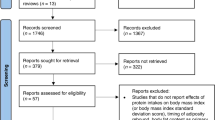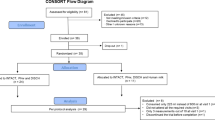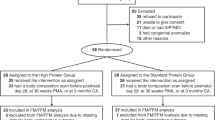Abstract
BACKGROUND:
Since breastfeeding and human milk seem to prevent, while high dietary proteins in the first 2 y of life seem to promote, later overweight, questions have been raised on the safe levels of proteins in the early years. How much protein (as a percentage of total calorie intake) is safe?
METHODS:
Revision of available data on the protein content of human milk, protein intake in the first 2 y of life and their association with body mass development.
RESULTS:
We should move from the figure of 7–8% in the 4-month exclusively breastfed infants up to the maximum acceptable levels of 14% in 12–24-month-old infants. When protein supply represents less than 6% and energy is limited, fully breastfed infants are likely to enter a status of negative nutrient balance. Over the limit of 14% energy from proteins in the 6–24 months period, some mechanisms may begin to operate, leading young children towards an early adiposity rebound and overweight development, beyond any genetic predisposition. Preliminary data seem to indicate a causal role for whole cow's milk proteins.
CONCLUSION:
We suggest maintaining breastfeeding as long as possible, and, in case human milk is insufficient, to introduce infant formulas, appropriate for age, up to 18–24 months, in order to keep protein intakes in the safe range of 8–12% within a diet adequate in energy and balanced as far as macronutrients.
This is a preview of subscription content, access via your institution
Access options
Subscribe to this journal
Receive 12 print issues and online access
$259.00 per year
only $21.58 per issue
Buy this article
- Purchase on Springer Link
- Instant access to full article PDF
Prices may be subject to local taxes which are calculated during checkout

Similar content being viewed by others
References
Barker DJ . Early growth and cardiovascular disease. Arch Dis Child 1999; 80: 305–307.
Singhal A, Cole TJ, Fewtrell M, Deanfield J, Lucas A . Is slower early growth beneficial for long-term cardiovascular health? Circulation 2004; 109: 1108–1113.
Singhal A, Lucas A . Early origins of cardiovascular disease: is there a unifying hypothesis? Lancet 2004; 363: 1642–1645.
Klaus M . Mother and infant: early emotional ties. Pediatrics 1998; 102 (Suppl E): 1244–1246.
Zetterstrom R . Breastfeeding and infant-mother interaction. Acta Paediatr 1999; 88 (Suppl 430): 1–6.
Schanler RJ . The use of human milk for premature infants. Pediatr Clin North Am 2001; 48: 207–219.
American Academy of Pediatrics. Breastfeeding and the use of human milk. Pediatrics 2005; 115: 496–506.
Hendricks KM, Badruddin SH . Weaning recommendations: the scientific basis. Nutr Rev 1992; 50: 125–133.
Von Kries R, Koletzko B, Sauerwald T, von Mutius E, Barnert D, Grunert V, von Voss H . Breastfeeding and obesity: cross sectional study. BMJ 1999; 319: 147–150.
Gillman MW, Rifas-Shilman SL, Camargo Jr CA, Berkey CS, Frazier AL, Rockett HR, Field AE, Colditz GA . Risk of overweight among adolescents who were breastfed as infants. JAMA 2001; 285: 2461–2467.
Armstrong J, Reilly JJ . Breastfeeding and lowering the risk of childhood obesity. Lancet 2002; 359: 2003–2004.
Grummer-Strawn LM, Mei Z . Does breastfeeding protect against pediatric overweight? Analysis of longitudinal data from the Centers for Disease Control and Prevention Pediatric Nutrition Surveillance System. Pediatrics 2004; 113: 81–86.
Toschke AM, Vignerova J, Lhotska L, Osancova K, Koletzko B, von Kries R . Overweight and obesity in 6- to 14- year-old Czech children in 1991: protective effect of breast-feeding. J Pediatrics 2002; 141: 764–769.
Dewey KG . Is breastfeeding protective against child obesity? J Hum Lact 2003; 19: 9–18.
Arenz S, Ruckerl R, Koletzko B, von Kries R . Breast-feeding and childhood obesity—a systematic review. Int J Obes Relat Metab Disord 2004; 28: 1247–1256.
Parsons TJ, Power C, Manor O . Infant feeding and obesity through the lifecourse. Arch Dis Child 2003; 88: 793–794.
Martorell R, Stein AD, Schroeder DG . Early nutrition and later adiposity. J Nutr 2001; 131 (Suppl): 874S–880S.
Metges CC . Does dietary protein in early life affect the development of adiposity in mammals? J Nutr 2001; 131: 2062–2066.
Heinig MJ, Nommsen LA, Peerson JM, Lonnerdal B, Dewey KG . Intake and growth of breast-fed and formula-fed infants in relation to the timing of introduction of complementary foods: the DARLING study. Acta Paediatr 1993; 82: 999–1006.
Taveras EM, Scanlon KS, Birch L, Rifas-Shiman SL, Rich-Edwards JW, Gillman MW . Association of breastfeeding with maternal control of infant feeding at age 1 year. Pediatrics 2004; 114: 577–583.
Baur LA, O’Connor J, Pan DA, Kriketos AD, Storlien LH . The fatty acid composition of skeletal muscle membrane phospholipid: its relationship with the type of feeding and plasma glucose levels in young children. Metabolism 1998; 47: 106–112.
Butte NF, Wong WW, Ferlic L, Smith EO, Klein PD, Garza C . Energy expenditure and deposition of breast-fed and formula-fed infants during early infancy. Pediatr Res 1990; 28: 631–640.
Butte NF, Wong WW, Hopkinson JM, Smith EO, Ellis KJ . Infant feeding mode affects early growth and body composition. Pediatrics 2000; 106: 1355–1366.
Lucas A, Bloom SR, Aynsley-Green A . Metabolic and endocrine events at the time of the first feed of human milk in preterm and term infants. Arch Dis Child 1978; 53: 731–736.
Lucas A, Boyes S, Bloom SR, Aynsley-Green A . Metabolic and endocrine responses to a milk feed in six-day-old term infants: differences between breast and cow's milk formula feeding. Acta Paediatr Scand 1981; 70: 195–200.
Lönnerdal B, Forsum E, Hambraeus L . A longitudinal study of the protein, nitrogen and lactose contents of human milk from Swedish well-nourished mothers. Am J Clin Nutr 1976; 29: 1127–1133.
Lönnerdal B . Nutritional and physiologic significance of human milk proteins. Am J Clin Nutr 2003; 77: 1537S–1543S.
Räihä NCR . Nutritional proteins in milk and the protein requirement of normal infants. Pediatrics 1985; 75: 136–141.
Räihä NCR . Protein content of human milk, from colostrum to mature milk. In: Räihä NCR (ed). Protein metabolism during infancy. Nestlé Nutrition Workshop Series, Vol. 33, Raven Press: New York; 1994. pp 87–99.
Ettinger S . Macronutrients: carbohydrates, proteins and lipids. In: Mahan LK, Escott-Stump S (eds). Krauses's Food, nutrition and diet therapy. WB Saunders Company: Philadelphia; 2000. pp 31–66.
Reeds PJ, Jahoor F . The amino acid requirements of disease. Clin Nutr 2001; 20: 15–22.
Reeds PJ, Garlick PJ . Protein and amino acid requirements and the composition of complementary foods. J Nutr 2003; 133: 2953S–2961S.
Dewey KG, Beaton G, Fjeld C, Lönnerdal B, Reeds P . Protein requirements of infants and children. Eur J Clin Nutr 1996; 50 (Suppl 1): S119–S150.
Scientific Committee on Food. Report of the Scientific Committee on Food on the revision of essential requirements of infant formulae and follow-on formulae. European Commission, SCF/CS/NUT/IF/65. http://europa.eu.int/comm/food/fs/sc/scf/index_en.html.
Lien E . Infant formulas with increased concentrations of alpha-lactalbumin. Am J Clin Nutr 2003; 77 (Suppl): 1555S–1558S.
Rigo J, Boehm G, Georgi G, Jelinek J, Nyambugabo K, Sawatzki G, Studzinski F . An infant formula free of glycomacropeptide prevents hyperthreoninemia in formula-fed preterm infants. J Pediatr Gastroenterol Nutr 2001; 32: 127–130.
EU Childhood Obesity programme. http://www.childhood-obesity.org/index.php.
Michaelsen KF, Hoppe C, Schack-Nielsen L, Molgaard C . Does an excessive protein intake early in life cause health problems such as obesity later in Life? In: Black RE, Michaelsen KF (eds). Public Health Issues in Infant and Child Nutrition, Vol. 48. Nestlé Nutrition Workshop Series, Lippincott Williams & Wilkins: Philadelphia; 2002. pp 279–291.
Rolland-Cachera MF, Deheeger M, Bellisle F, Sempé M, Guilloud-Bataille M, Patois E . Adiposity rebound in children: a simple indicator for predicting obesity. Am J Clin Nutr 1984; 39: 129–135.
Rolland-Cachera MF, Deheeger M, Akrout M, Bellisle F . Influence of macronutrients on adiposity development: a follow up study of nutrition and growth from 10 months to 8 years of age. Int J Obes Realt Metab Disord 1995; 19: 573–578.
Scaglioni S, Agostoni C, Notaris RD, Radaelli G, Radice N, Valenti M, Giovannini M, Riva E . Early macronutrient intake and overweight at five years of age. Int J Obes Realt Metab Disord 2000; 24: 777–781.
Dorosty AR, Emmett PM, Cowin IS, Reilly JJ . Factors associated with early adiposity rebound. Pediatrics 2000; 105: 1115–1118.
Scaglioni S, Verduci E, Fiori L, Lammardo AM, Rossi S, Radaelli G, Riva E, Giovannini M . Body mass index rebound and overweight at 8 years of age in hyperphenylalaninemic children. Acta Paediatr 2004; 93: 1596–1600.
Rolland-Cachera MF, Deheeger M, Bellisle F . Early adiposity rebound is not associated with energy or fat intake in infancy. Pediatrics 2001; 108: 218–219.
Ketelslegers JM, Maiter D, Maes M, Underwood LE, Thissen JP . Nutritional regulation of insulin-like growth factor-I. Metabolism 1995; 44 (Suppl 4): 50–57.
Soriski A . From preadipocyte to adipocyte: differentiation-directed signals of insulin from the cell surface to the nucleus. Crit Rev Clin Lab Sci 1999; 36: 1–34.
Rolland-Cachera MF, Deheeger M, Bellisle F . Increasing prevalence of obesity among 18-year-old males in Sweden: evidence for early determinants. Acta Paediatr 1999; 88: 365–367.
Hoppe C, Udam TR, Lauritzen L, Juul A, Michaelsen KF . Animal protein intake, serum insulin-like growth factor I, and growth in healthy 2.5-y-old Danish children. Am J Clin Nutr 2004; 80: 447–452.
Hoppe C, Molgaard C, Juul A, Michaelsen KF . High intakes of skimmed milk, but not meat, increase serum IGF-I and IGFBP-3 in eight-year-old boys. Eur J Clin Nutr 2004; 58: 1211–1216.
Hoppe C, Molgaard C, Vaag A, Barkolt V, Michaelsen KF . High intakes of milk, but not meat, increase s-insulin and insulin resistance in 8-year-old boys. Eur J Clin Nutr 2005; 59: 393–398.
Roe DA . Diet, nutrition and drug reactions. In: Shils ME, Young VR (eds). Modern nutrition in health and disease, 7th edn. Lea & Febiger: Philadelphia; 1988. pp 630–645.
Author information
Authors and Affiliations
Corresponding author
Rights and permissions
About this article
Cite this article
Agostoni, C., Scaglioni, S., Ghisleni, D. et al. How much protein is safe?. Int J Obes 29 (Suppl 2), S8–S13 (2005). https://doi.org/10.1038/sj.ijo.0803095
Published:
Issue Date:
DOI: https://doi.org/10.1038/sj.ijo.0803095
Keywords
This article is cited by
-
Protein and growth during the first year of life: a systematic review and meta-analysis
Pediatric Research (2023)
-
Macronutrient balance and micronutrient amounts through growth and development
Italian Journal of Pediatrics (2021)
-
Different Protein Sources in the Maternal Diet of the Rat during Gestation and Lactation Affect Milk Composition and Male Offspring Development during Adulthood
Reproductive Sciences (2021)
-
Sicherheit und Risiken vegetarischer und veganer Ernährung in Schwangerschaft, Stillzeit und den ersten Lebensjahren
Monatsschrift Kinderheilkunde (2019)
-
Effects of dietary protein restriction followed by realimentation on growth performance and liver transcriptome alterations of lamb
Scientific Reports (2018)



